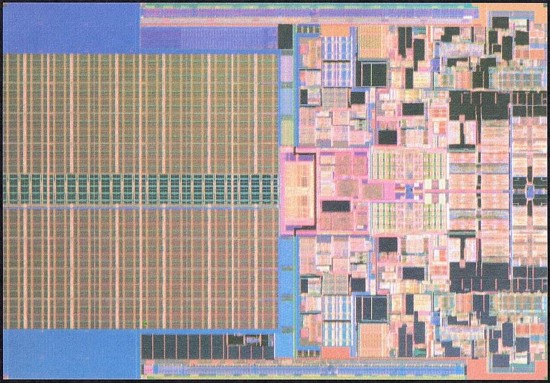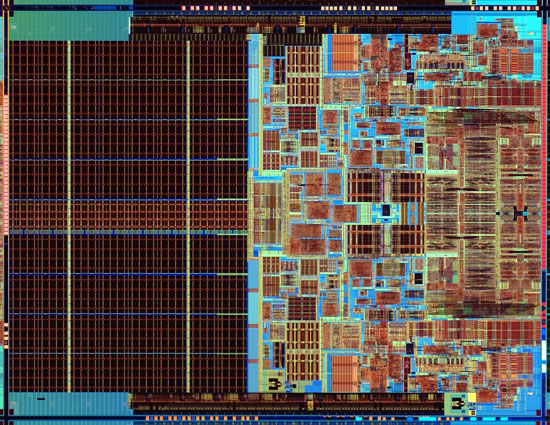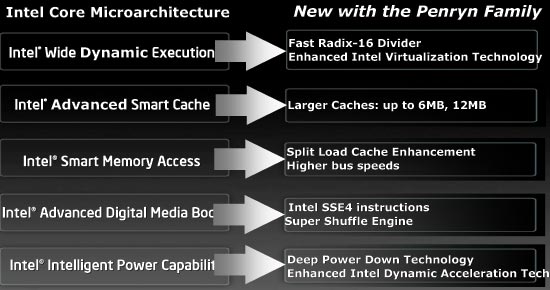The Penryn Preview - Part I: Wolfdale Performance
by Anand Lal Shimpi on August 21, 2007 12:35 PM EST- Posted in
- CPUs
By the end of this year, AMD will introduce Phenom and Intel will introduce Penryn - its first 45nm desktop CPU.
For a while there we wondered how Intel would introduce Penryn into its lineup, but as of Intel's last roadmap update we now know. On top of that, we managed to get our hands on a dual-core Penryn so now we know exactly how fast the new core is going to be. Combine the two datapoints and there's a wealth of knowledge to share. So gather 'round the fire, it's time to benchmark CPUs.
Recapping Penryn
Penryn is more than just a die-shrunk Conroe, but it isn't anywhere near as revolutionary as what Conroe was to its predecessor. The Conroe-Penryn evolution is one cycle of Intel's tick-tock model, Penryn's successor (Nehalem) will be the next revolutionary core you see out of Intel (at least that's what we're expecting).

Penryn is built on Intel's 45nm process, thus dropping power consumption increasing switching speed and allowing Intel to cram more transistors on a die (107mm^2 for dual-core Penryn vs. 143mm^2 for Conroe).

A dual-core Penryn die

A dual-core Conroe die
Intel lists the following 9 enhancements as what's new in the Penryn family:

The faster divider and super shuffle engine will increase performance in very specific applications and won't be broad increasers of performance. The larger caches obviously will increase performance, but prior to today we weren't sure by how much.
SSE4 support can bring about tremendous performance improvements, but it requires software optimization. In our initial Penryn Preview we reported an over 100% increase in performance in SSE4 optimized DivX encoding for a quad-core Penryn at 3.33GHz vs. a quad-core Kentsfield at 2.93GHz.
We detailed all of the Penryn enhancements and the markets they impact in our original Penryn article. Keep in mind that things like Penryn's Deep Power Down Technology and higher bus speeds may not apply to all Penryn cores (the former is only in Mobile Penryn while the latter will appear on servers first).
Never Take Sides Against the Family
Penryn is the overall family name but there are two cores in particular that we'll be talking about today: Wolfdale and Yorkfield.
Wolfdale is a dual-core desktop Penryn core with a 6MB L2 cache shared between the two cores. Yorkfield is two Wolfdales on the same package, giving the quad-core CPU a total of 12MB of L2 cache.
Wolfdale and Yorkfield are architecturally identical, so performance per core is no different between the processors - Yorkfield simply has more cores.










55 Comments
View All Comments
Affectionate-Bed-980 - Thursday, August 23, 2007 - link
My God. Then maybe they should think about reviews when dealing with NDAs. Just because I didnt have to pay for this article doesn't mean people can't complain.Remember those Conroe reviews done by HardOCP or something that were just GPU limited? Of course people have a right to complain about crappy reviews.
Beenthere - Wednesday, August 22, 2007 - link
Nothing here but ad hype for sure. Intel looks desperate.AnnonymousCoward - Saturday, August 25, 2007 - link
Since when does a process node transition mean the company is desperate??fitten - Thursday, August 23, 2007 - link
Why would Intel be despirate? you think 2GHz Barcelona (which isn't the desktop chip) scares them?coldpower27 - Wednesday, August 22, 2007 - link
Assuming that a E6550 consumes 8-10W at idle and 55W at load which shouldn't be too far off from the proper numbers and is a reasonable estimate.
Then your looking at 3-5W for idle and something like 37W for load, very impressive considering the Wolfdale SKU's on the desktop are going to retain their 65W TDP.
n0nsense - Wednesday, August 22, 2007 - link
wtf ?32bit system performance tests on 64bit hardware ?
lets test it on PII.
if you can't find native 64bit soft for MS, look at real OSes.
need new optimizations ? compile open source programs with new flags enabled.
and one more thing.
compilation test will be very good
johnsonx - Wednesday, August 22, 2007 - link
Ever since this:http://www.dailytech.com/article.aspx?newsid=8313&...">http://www.dailytech.com/article.aspx?n...amp;thre...
I can't help but laugh when I see the first chart on page one.
strikeback03 - Wednesday, August 22, 2007 - link
bwahahaPenryn enhancements indeed
TA152H - Tuesday, August 21, 2007 - link
I somehow remember having an argument with all the dolts that were claiming massive IPC improvements for this core and how hopeless the Barcelona was since it would be against the Penryn. It surely does not look to be impossible to me, not even close. Considering the massive improvements AMD gets over time with their process technology, and large improvements vis-a-vis the K8, this looks to be the most competitive the companies have been for quite some time.Not that I am bad mouthing Intel, they did an amazing job not only increasing the size of the cache, but also lowering the latency. The problem is that so many people were expecting the impossible, and now are disappointed because they really don't know anything about microprocessors. It's not Intel's fault, it's still a great product. Lower power, better performance and smaller size compared to a fantastic processor is something they deserve a lot of credit for. But, it's not going to walk away from the Barcelona, especially on servers.
Higher clock speeds would probably show greater improvement, since it's got a larger cache, and going to four cores would as well, but the reality is, it's not going to be a big improvement on most apps. It's also going to be relatively simple for AMD to increase cache sizes, particularly since they added wait states to the L2 cache so it could be bigger if they chose (again illustrating how amazing Intel was for increasing size and speed).
By the time this processor is out though, AMD will not only have corrected the most egregious speed path problems for Barcelona, but they will also be further along on their 65nm process, and if history is any indication (and it normally is), AMD will do a great job in improving their manufacturing on 65nm. All in all, it's not going to be easy for Intel. Or AMD.
AbRASiON - Tuesday, August 21, 2007 - link
I believe those idiots were hopeful of extremely high clocks actually.It doesn't matter how performance is delivered, 10mhz of ultra optimised CPU or 10ghz of poorly optomised, all we want is speed and AMD is yet to show us the money.